The Milk Pasteurization Machines Market is estimated to be valued at USD 8.1 billion in 2025 and is projected to reach USD 18.1 billion by 2035, registering a compound annual growth rate (CAGR) of 8.4% over the forecast period.
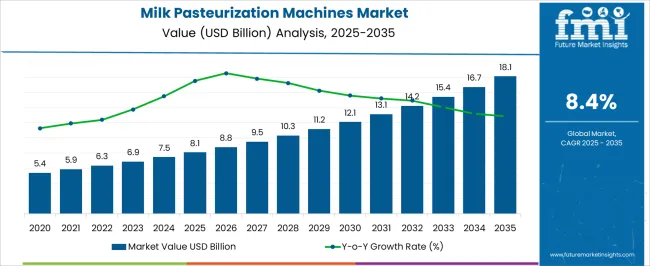
| Metric | Value |
|---|---|
| Milk Pasteurization Machines Market Estimated Value in (2025 E) | USD 8.1 billion |
| Milk Pasteurization Machines Market Forecast Value in (2035 F) | USD 18.1 billion |
| Forecast CAGR (2025 to 2035) | 8.4% |
The milk pasteurization machines market is advancing steadily as dairy producers prioritize food safety, quality, and regulatory compliance. The increasing demand for pasteurized milk products driven by consumer health awareness and stringent hygiene standards has been a significant growth catalyst. Industry trends indicate a shift towards automation and efficient pasteurization techniques that optimize processing speed and energy consumption.
Investments in modern dairy infrastructure and expansion of the dairy sector in emerging regions are further driving demand. The adoption of continuous processing methods and advanced high-temperature short time techniques reflects the market’s focus on improving throughput and preserving milk quality.
Future opportunities are expected to arise from technological innovations that enhance operational efficiency while reducing environmental impact. Growing consumer preference for safe and fresh dairy products alongside regulatory mandates is anticipated to sustain momentum in this market.
The market is segmented by Product Type, Technique, Method, and Capacity and region. By Product Type, the market is divided into Automatic and Semi-Automatic. In terms of Technique, the market is classified into High-Temperature Short Time (HTST), Higher Heat Shorter Time (HHST), Ultra High Temperature (UHT), and Ultra-Pasteurized (UP). Based on Method, the market is segmented into Continuous and Batch-wise. By Capacity, the market is divided into Between 10,000–40,000 l/h, Less than 10,000 l/h, and More than 40,000 l/h. Regionally, the market is classified into North America, Latin America, Western Europe, Eastern Europe, Balkan & Baltic Countries, Russia & Belarus, Central Asia, East Asia, South Asia & Pacific, and the Middle East & Africa.
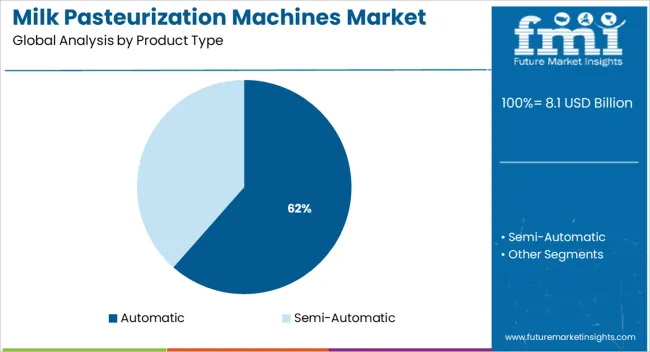
When segmented by product type, the automatic segment is expected to hold the majority of market revenue in 2025 with a share of 61.5%. This segment’s leadership is attributed to the increasing demand for machines that offer enhanced precision, reduced manual intervention, and improved operational efficiency.
Automation has enabled consistent pasteurization quality, minimized human error, and lowered labor costs, which have been pivotal for large-scale dairy operations. The integration of programmable controls and monitoring systems has also facilitated compliance with strict food safety standards.
Manufacturers’ focus on developing user-friendly automatic machines with faster processing capabilities has further supported this segment’s growth. The ability to handle varying production volumes efficiently has made automatic machines the preferred choice among dairy producers seeking to optimize performance and throughput.
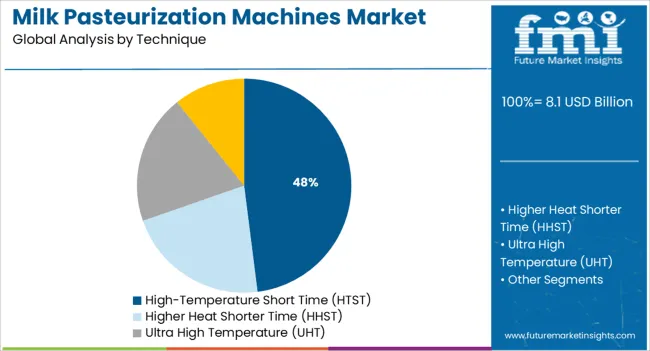
The high temperature short time technique is projected to command a significant portion of market revenue in 2025, accounting for 48.0% of the total share. This technique’s dominance is driven by its ability to effectively eliminate pathogens while preserving the nutritional and sensory qualities of milk.
Its relatively shorter processing time compared to traditional methods has made it favorable for high-volume dairy producers aiming to maximize productivity. Adoption has been accelerated by regulatory endorsement of HTST as a standard pasteurization method in many countries.
Technological advancements have enabled better control of temperature and timing parameters, ensuring consistent product quality. The combination of improved safety, operational efficiency, and product shelf life has solidified the position of the high temperature short time technique as the leading pasteurization method.
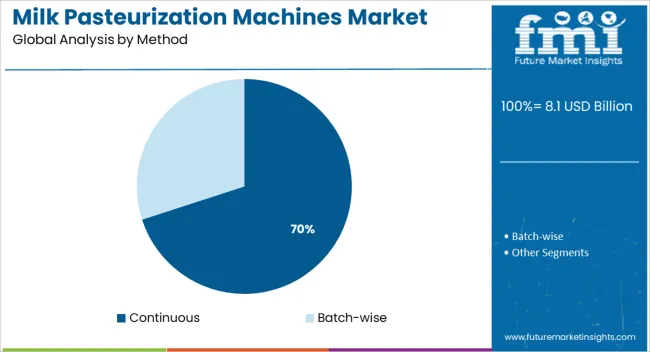
Segmenting by method reveals that the continuous method is expected to account for the largest revenue share of 70.0% in 2025, maintaining its lead in the market. This method’s prominence is primarily due to its suitability for large-scale industrial milk processing where uninterrupted operations are critical.
Continuous pasteurization ensures consistent heat treatment, improved throughput, and better energy utilization compared to batch processing. Dairy processors favor this method for its ability to maintain steady product quality and reduce processing times.
The efficiency gains and scalability offered by continuous systems have encouraged widespread adoption among both established and expanding dairy enterprises. Operational cost savings coupled with compliance to food safety standards have reinforced the continuous method’s dominant position in the pasteurization machines market.
The global milk pasteurization machines market is anticipated to grow at 8.4% CAGR between 2025 and 2035 in comparison to the 6.2% CAGR registered during the historical period of 2020 to 2025.
The rapid growth of the dairy industry across the world and the increasing need for extending the shelf life of milk and milk-based products are some of the key factors driving the growth of the global milk pasteurization machines market.
Similarly, due to several variables, including increasing milk production, consumption, and manufacturing automation in the dairy industry, the milk pasteurization machines market has promising development potential.
Milk processing companies use pasteurization processes to eliminate pathogens from raw milk and extend its shelf life. For this purpose, they employ various automatic and semi-automatic milk pasteurization machines. This will continue to boost the market during the forecast period.
Regionally, North America holds the largest market share, and it is expected to continue to expand during the projection period. This can be attributed to the rising consumption of dairy-based products, growing adoption of automation in milk processing industries, and favorable legal and regulatory environment.
Rising Production and Consumption of Dairy-based Items Boosting Market
Over the years, there has been a rapid surge in the consumption of dairy-based products, especially across developed and developing nations like the USA, the UK, Japan, India, and China.
People across these regions are spending large amounts on milk-based products such as cheese, yogurt, butter, and ice-creams due to their high nutritional content. This is playing a crucial role in expanding the milk pasteurization machines market.
Similarly, the growing popularity of pasteurized milk across industries like bakeries, confectionery, and dietary supplements is likely to propel the demand for milk pasteurization machines during the forecast period.
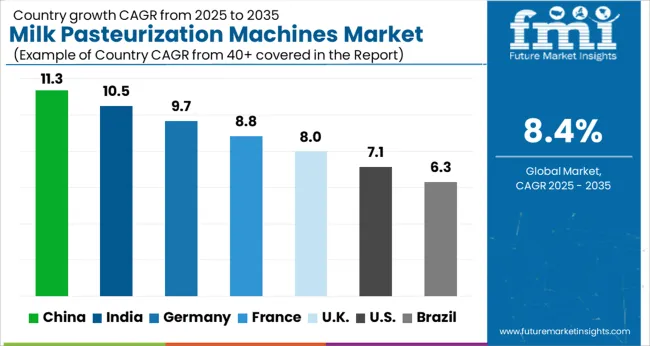
Increasing Consumption of Dairy-based Products Pushing Demand in the USA
According to FMI, the USA milk pasteurization machines market is estimated at around USD 8.1 Million in 2025 and it holds the largest share of 68% in the North American market. Furthermore, with rising support from the federal and state government and huge investments in innovation and automation, the USA is likely to lead the global milk pasteurization machines market.
Rising consumption of dairy-based products, growing adoption of automation, and the heavy presence of leading manufacturers are some of the key factors driving growth in the USA milk pasteurization machines market.
Over the years, there has been a sharp rise in the consumption of milk-based products like cheese and yogurt across the USA For instance, as per the International Dairy Foods Association, American dairy per capita consumption across products consistently has been increasing each year, with 2020 up 6% over the past five years, 10% over the past 15 years, and 16% over the past 30 years. This will continue to boost the milk pasteurization machines market in the country over the next ten years.
Similarly, with the rapid expansion of industries like the dietary supplement industry, baking industry, and confectionary industry, demand for milk pasteurization machines is likely to grow at a robust pace across the USA through 2035.
Increasing Adoption of Automation Pushing Demand in Germany
The UK milk pasteurization machines market is estimated to be worth roughly USD 216.3 Million in 2025 and it is poised to expand at a healthy pace during the next ten years. Increasing dairy product consumption, the surge in the number of new start-ups, and the availability of advanced machinery are expected to drive the UK milk pasteurization machines market.
Similarly, the rapid growth of the dairy equipment industry in the UK and the ease of exporting dairy equipment to various countries with the help of free trade agreements between the UK and other countries are contributing to the expansion of the milk pasteurization machines market in the country.
In addition to this, the rising adoption of automation by milk processing companies to improve product quality and reduce errors is expected to propel sales of milk pasteurization machines in Germany during the forecast period.
Rising Export of Advanced Machinery Boosting Milk Pasteurization Machines Market in Germany
As per FMI, demand for milk pasteurization machines across Germany is expected to grow at a strong pace during the forecast period, owing to the rise in the export of advanced machinery, favorable government support, and the strong presence of leading manufacturers such as GEA Engineering and Krones AG.
The machinery and equipment sector contribute significantly to Germany’s GDP. The majority of the world's exports of machinery and equipment come from Germany. The milk pasteurization machine industry in Germany is thriving thanks to automation in machine manufacture and the flexibility of export law.
Growing Need for Reducing Human Intervention Fuelling Adoption of Automatic Machines
Based on product type, the global milk pasteurization machines market is segmented into automatic and semi-automatic. Among these, the automatic milk pasteurization machines segment is likely to grow at the fastest pace during the forecast period.
This can be attributed to the rising adoption of automatic machines by milk processing companies to reduce human intervention, improve overall productivity, and reduce labor costs. Besides this, the growing need for improving product quality and safety is expected to further push the demand for automatic milk pasteurization machines during the forecast period.
The ability of Ultra High-Temperature Technique to Significantly Increase Shelf Life of Milk Products
As per FMI, the ultra-high temperature segment is expected to generate the largest revenue share in the global milk pasteurization machines market during the forecast period. This can be attributed to the rising adoption of ultra-high-temperature pasteurization techniques for milk production.
Ultra-high-temperature (UHT) technique involves heating milk or cream to 138-150 °C for one or two seconds. It has gained immense popularity among users on account of its ability to convert highly perishable milk into a product with a shelf life extended from days to a month and can be stored and transported without refrigeration conditions.
Leading players in the milk pasteurization machines market are adopting strategies such as new product launches, partnerships, mergers, acquisitions, and collaborations to gain a competitive edge in the market. For instance,
| Attribute | Details |
|---|---|
| Estimated Market Size (2025) | USD 8.1 billion |
| Projected Market Size (2035) | 8.4% CAGR |
| Anticipated Growth Rate (2025 to 2035) | USD 6,882 Million |
| Forecast Period | 2025 to 2035 |
| Historical Data Available for | 2020 to 2025 |
| Market Analysis | USD Million for Value and Units for Volume |
| Key Regions Covered | North America; Latin America; Europe; Asia Pacific; Oceania; Middle East and Africa (MEA) |
| Key Countries Covered | USA, Canada, Mexico, Germany, UK, France, Italy, Spain, China, Japan, India, South Korea, Malaysia, Thailand, Indonesia, Australia, Brazil, Argentina, South Africa, UAE |
| Key Segments Covered | Product Type, Method, Technique, Capacity, Region |
| Key Companies Profiled | Dion Engineering; GEA Group; Krones; SPX Flow (APV); Tetra Pak International; ABL Technology; Della Toffola; INOXPA; KHS; SEPAK Industries.; REDA S.P.A.; Shanghai Jimei Food Machinery; TESSA I.E.C Group; Stephan Machinery Gmbh; GOMA Engineering; Nanjing Prosky Food Machinery ; Manufacturing Co. Ltd; JBT; Neologic Engineers Private Ltd.; M&E Trading Gmbh & Co KG; Iwai Kikai Kogyo Co. Ltd; Machine Point Group; Paul Mueller Company; IMA Group; Alfa Laval; Elecster Oyj; Shanghai Triowin Intelligent Machinery; Microthermics; Feldmeier Equipment Inc; Scherjon Dairy Equipment Holland B.V.; Highland Equipment Inc.; Repute Engineers Private Limited; Midland (ADM); Wilmar International (Singapore) |
| Report Coverage | Market Forecast, Company Share Analysis, Competitive Landscape, Drivers, Restraints, Opportunities and Threats Analysis, Market Dynamics and Challenges, and Strategic Growth Initiatives |
The global milk pasteurization machines market is estimated to be valued at USD 8.1 billion in 2025.
The market size for the milk pasteurization machines market is projected to reach USD 18.1 billion by 2035.
The milk pasteurization machines market is expected to grow at a 8.4% CAGR between 2025 and 2035.
The key product types in milk pasteurization machines market are automatic and semi-automatic.
In terms of technique, high-temperature short time (htst) segment to command 48.0% share in the milk pasteurization machines market in 2025.






Full Research Suite comprises of:
Market outlook & trends analysis
Interviews & case studies
Strategic recommendations
Vendor profiles & capabilities analysis
5-year forecasts
8 regions and 60+ country-level data splits
Market segment data splits
12 months of continuous data updates
DELIVERED AS:
PDF EXCEL ONLINE
Milk Carton Market Size and Share Forecast Outlook 2025 to 2035
Milking Automation Market Size and Share Forecast Outlook 2025 to 2035
Milking Robots Market Size and Share Forecast Outlook 2025 to 2035
Milk Packaging Market Size and Share Forecast Outlook 2025 to 2035
Milk Clarifier Market Size and Share Forecast Outlook 2025 to 2035
Milk Homogenizer Machine Market Size and Share Forecast Outlook 2025 to 2035
Milk Sterilizer Machine Market Size and Share Forecast Outlook 2025 to 2035
Milk Powder Packaging Market Size and Share Forecast Outlook 2025 to 2035
Milk Protein Market - Size, Share, and Forecast 2025 to 2035
Milk Ingredients Market Analysis - Size, Share, and Forecast Outlook 2025 to 2035
Milk Mineral Concentrate Market Trends-Demand, Innovations & Forecast 2025 to 2035
Milk Thistle Market Analysis by Form, Distribution Channel and Region through 2035
Milk Powder Market Analysis by Type, Distribution Channel, Region and Other Applications Through 2035
Milk Tank Cooling System Market Growth – Trends & Forecast 2025 to 2035
Milk Alternatives Market – Growth, Demand & Dairy-Free Trends
Milk Protein Hydrolysate Market Growth - Infant Nutrition & Functional Use 2024 to 2034
Milking Equipment Market
Milk Bottle Market Trends & Industry Growth Forecast 2024-2034
Milk Fat Fractions Market
Milk Retentate Market

Thank you!
You will receive an email from our Business Development Manager. Please be sure to check your SPAM/JUNK folder too.
Chat With
MaRIA